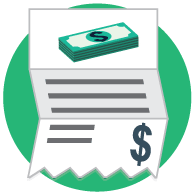 If you’re a small business owner, you’ve probably received a fax, e-mail or phone call about obtaining a “merchant cash advance”. Merchant cash advances are a form of business funding that should, in theory, fall between a loan and an investment. Because it’s not a loan, there is no “interest” associated with it. Instead there is a fixed payback. The fixed payback is often determined by a “factor rate”, which can be deceiving because A/R factoring is not involved. What follows below is a quick explanation of this funding mechanism and how merchant cash advance rates are calculated.
If you’re a small business owner, you’ve probably received a fax, e-mail or phone call about obtaining a “merchant cash advance”. Merchant cash advances are a form of business funding that should, in theory, fall between a loan and an investment. Because it’s not a loan, there is no “interest” associated with it. Instead there is a fixed payback. The fixed payback is often determined by a “factor rate”, which can be deceiving because A/R factoring is not involved. What follows below is a quick explanation of this funding mechanism and how merchant cash advance rates are calculated.
What is a Merchant Cash Advance?
A merchant cash advance is an advance of future business revenues. The funding company will purchase a fixed amount of your future revenues, for lump sum cash up front. A sample deal would be a purchase of the next $13,000 of your revenues in the future, in exchange for $10,000 right now. The funding amounts are largely based on cash flow, like total monthly credit card transaction volume or business bank deposits. Payback would be a fixed % of all future moneys that come in – explained in more detail below. Learn more about the merchant cash advance, also known as cash flow funding.
Merchant Cash Advance Rates
In the above example, the merchant cash advance fees would be 30%. The total repayment on $10,000 would be $13,000. This would be a “factor rate” of 1.30. To calculate the total payback on the funding amount of $10,000, multiply the funded amount by the factor rate ($10,000 x 1.30) to obtain the payback. The payback is often called the purchased amount.
Many people tend to annualize the fee as an APR but this is incorrect. First, it is not a loan so calculating an interest rate is inherently faulty. Secondly, because the funding company is only receiving a fixed percentage of all future moneys as repayment on the advance, the length of time they will collect is often unknown. For example, if the funding company says “I will pay you $10,000 right now, in exchange for the next $13,000, and you will pay me back 10% of every credit card swipe, until I get my $13,000, no matter how long it takes”.
If tomorrow you have a huge downturn in business and your daily credit card volume drops from $1,000 to $100, the funding company will be taking 10% of $100, not $1,000. Similarly, if your business started to boom and you started to process $2,000 per day in credit cards, the funding company would receive $200 per day. Again, the length of repayment is unknown, so it’s not correct to calculate an APR based on merchant cash advance rates. The reason why is that you don’t know how long it will take to pay off.
Merchant Cash Advance Rates: Cheat Sheet
Moving forward, keep these things in mind if you’re shopping for a merchant cash advance:
- The payback is called the “factor” rate, which is fixed.
- The funded amount is the “advanced” amount.
- The repayment amount is the “purchased” amount
- Repayment is done by remitting a portion of every sale until the purchased amount is met.
- The portion of every sale paid back will be either 1) a fixed percentage of your daily credit card revenues, or 2) a fixed dollar amount debited directly out of your bank account.
Look for Hidden Fees
Fees increase the overall merchant cash advance rates the factor rate sticker price. Look for an Addendum or Appendix to the agreement that detail the fees. These are usually buried in the back of the contract. Ask your broker representative or the direct funder what you will be charged for and don’t move forward until you have a clear idea of what the fees are. If you’re working with a broker, look for a fee that says “PFS” or “Professional Services Fee”. This is basically a finders fee and is usually placed on top of the commission the funder is paying the broker. Push back on the fees, they’re often times egregious – especially if your funder is located on Pearl Street or in New Jersey!
